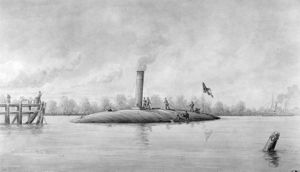CSS Manassas

| |
| History | |
|---|---|
| Name | Manassas; originally Enoch Train |
| Namesake | Battle of First Manassas; Enoch Train |
| Owner | Boston Steam Tow-Boat Co.[1] |
| Builder | James. O. Curtis, Medford, Massachusetts[1] |
| Launched | 1853[1] or 1855 |
| Commissioned | September 12, 1861 |
| Decommissioned | April 24, 1862 |
| Fate | Sunk in battle April 24, 1862 |
| General characteristics | |
| Class and type | Steam tug,[1] Ironclad |
| Displacement | 387 tons |
| Tons burthen | 384+1⁄2 tons[1] |
| Length | 143 ft (44 m) |
| Beam | 33 ft (10 m) |
| Draft | 17 ft (5.2 m) |
| Propulsion | Steam engine |
| Complement | 36 officers and men |
| Armament | One 64-pounder Dahlgren, later replaced by one 32-pounder |

CSS Manassas, formerly the steam
Description
Covered with 1.25-inch (32 mm) iron plating, her above-water hull was reshaped into a curved "turtle-back" form; at its lowest when fully loaded, the hull projected only 6+1⁄2 feet above the
: 68–9Service history
Commissioned as a
Under Lieutenant Warley, CSS Manassas joined the force of Captain John K. Mitchell, CSN, commanding Confederate naval forces in the lower Mississippi. She participated in the


After this action Manassas followed the Union fleet quietly for a while, but as she drew closer Mississippi furiously turned on her and made an attempt to ram the ironclad. Manassas managed to dodge the blow but ran aground in the process. Her crew managed to escape as Mississippi poured heavy broadsides into the stranded Confederate ram. Now on fire, Manassas slipped off the bank and drifted down the river past the Union mortar flotilla. Commander David Dixon Porter, USN, in command of the mortar boats, tried to save her as an engineering curiosity, but Manassas exploded and immediately plunged under water, a total loss.[8] In 1981, the National Underwater and Marine Agency located the suspected wreckage of the Manassas under a current levee on the bank of the Mississippi.[9]
Years after the war, in the book Battles and Leaders of the Civil War,[10] there was a claim that a Manassas crewman was knocked off the ironclad by a Union sailor; however Lieutenant Warley reported no casualties among his Manassas crew in an official report dated 13 August 1863.[11]
References
- This article incorporates text from the public domain Dictionary of American Naval Fighting Ships. The entry can be found here.
Notes
- Abbreviations used in these notes
- Official atlas: Atlas to accompany the official records of the Union and Confederate armies.
- ORA (Official records, armies): War of the Rebellion: a compilation of the official records of the Union and Confederate Armies.
- ORN (Official records, navies): Official records of the Union and Confederate Navies in the War of the Rebellion.
- ^ a b c d e Gleason, Hall (1937). Old Ships and Ship-Building Days of Medford. Medford, MA: J.C. Miller. p. 77.
- ^ ORN I, v. 18, p. 131.
- ^ A history of the United States Navy from 1775 to 1902, Volume 2, Edgar Stanton Maclay, Roy Campbell Smith, p. 315
- ^ CSS Manassas http://www.history.navy.mil/photos/sh-us-cs/csa-sh/csash-mr/manassas.htm Archived 2012-02-03 at the Wayback Machine
- ISBN 0-8071-1945-8.
- ^ Hearn, pp. 86–91.
- ^ Hearn, pp. 210–35.
- ^ Hearn, pp. 235–6.
- ^ Cussler, Clive. "Search for the Ironclads". NUMA. Retrieved March 22, 2024.
- ^ Vol 2.p.67
- ^ ORN 1, 18, p. 337
Bibliography
- Bisbee, Saxon T. (2018). Engines of Rebellion: Confederate Ironclads and Steam Engineering in the American Civil War. Tuscaloosa, Alabama: University of Alabama Press. ISBN 978-0-81731-986-1.
- Canney, Donald L. (2015). The Confederate Steam Navy 1861-1865. Atglen, Pennsylvania: Schiffer Publishing. ISBN 978-0-7643-4824-2.
- Silverstone, Paul H. (2006). Civil War Navies 1855–1883. The U.S. Navy Warship Series. New York: Routledge. ISBN 0-415-97870-X.
- Still, William N. Jr. (1985) [1971]. Iron Afloat: The Story of the Confederate Armorclads. Columbia, South Carolina: University of South Carolina Press. ISBN 0-87249-454-3.
External links
 Media related to CSS Manassas (ship, 1855) at Wikimedia Commons
Media related to CSS Manassas (ship, 1855) at Wikimedia Commons- CSS Manassas at the Naval Historical Center
